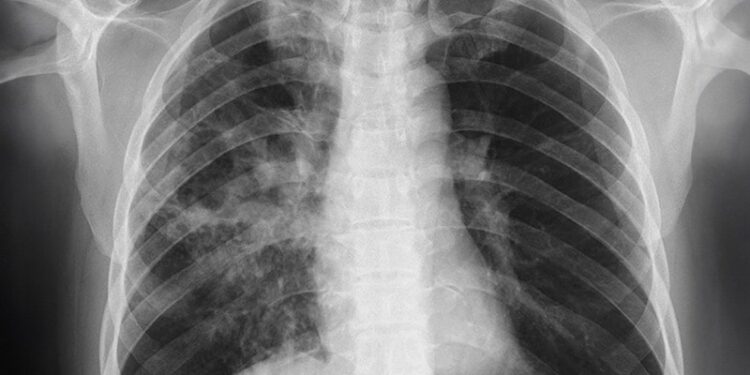TOPLINE:
Three years after the initial wave, over half of adult survivors of severe COVID-19 in a New York City-based cohort continued to exhibit fibrotic-like lung abnormalities, primarily reticulations and traction bronchiectasis.
METHODOLOGY:
- This longitudinal, prospective study assessed the prevalence of fibrotic-like abnormalities and associated clinical factors in survivors of COVID-19 from New York City, 3 years postinfection.
- Researchers enrolled 102 patients (mean age, 60 years; 54% men; 61% non-White) who were hospitalized with severe or critical COVID-19 between March and May 2020 and required oxygen supplementation.
- All patients underwent noncontrast high-resolution CT of the chest to identify the presence of abnormalities, including reticulation, honeycombing, ground glass opacities, and traction bronchiectasis.
- Clinical assessments included spirometry and diffusion capacity of carbon monoxide (DLCO), alongside assessments of 6‐minute walk distance (6MWD) to evaluate lung function.
- Frailty was assessed by gait speed, grip strength, weight loss (decrease of > 10 lb since hospitalization), low physical activity, and exhaustion.
TAKEAWAY:
- Radiologic abnormalities were present in 67% of patients, with 61% exhibiting fibrotic-like patterns, predominantly reticulations (94%) and bronchiectasis (74%), while 68% showed both reticulations and traction bronchiectasis.
- Male sex, a lower BMI, a shorter telomere length, a higher sequential organ failure assessment score, and a longer duration of mechanical ventilation were associated with increased odds of fibrotic-like abnormalities (P ≤ .01 for all), whereas Black race was negatively associated (P = .04).
- Forced vital capacity and DLCO remained unchanged over time. After adjusting for disease severity, only percent-predicted 6MWD remained significantly associated with fibrotic-like abnormalities.
- Fibrotic-like abnormalities decreased modestly over time, but none resolved completely.
IN PRACTICE:
“Continued follow-up of longitudinal post-COVID cohorts will be needed to assess the reversibility or irreversibility of lingering fibrotic-like abnormalities,” wrote the authors of the study.
SOURCE:
The study was led by Scarlett Murphy, MD, Division of Pulmonary, Allergy, and Critical Care Medicine, Columbia University Irving Medical Center, New York City. It was published online on July 1, 2025, in Annals of the American Thoracic Society.
LIMITATIONS:
The study experienced attrition between the 15-month and 3-year follow-up periods. The radiologic scoring system’s categorization introduced potential variability in scores over time and between readers. The relatively small sample size, lack of a replication cohort, limited number of imaging studies for air trapping evaluation, and the need to use propensity scores for covariate adjustment were additional limitations.
DISCLOSURES:
The study was supported by grants from the National Institutes of Health and the Department of Defense. Six authors reported receiving financial support from pharmaceutical organizations, including Boehringer Ingelheim, Genentech, Bioclinica, AbbVie, LungLife AI, and AstraZeneca.
This article was created using several editorial tools, including AI, as part of the process. Human editors reviewed this content before publication.
Source link : https://www.medscape.com/viewarticle/lung-abnormalities-persist-3-years-after-severe-covid-19-2025a1000j3b?src=rss
Author :
Publish date : 2025-07-18 10:21:00
Copyright for syndicated content belongs to the linked Source.









